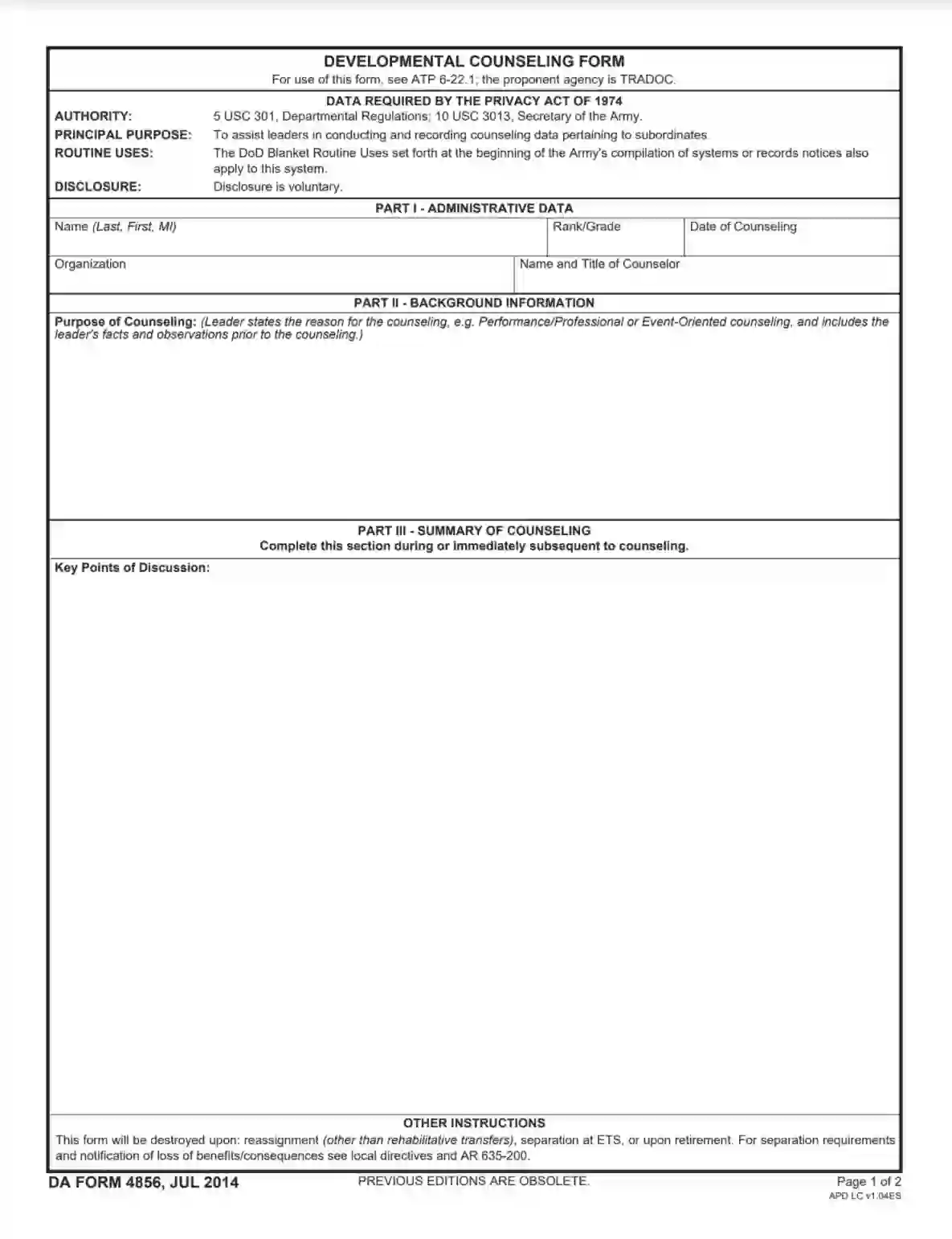DA Form 4856, officially known as the “Developmental Counseling Form,” is a form used primarily for the purpose of documenting counseling sessions between leaders and their subordinates. The form facilitates a structured process for leaders to provide feedback, address performance issues, set goals, and outline expectations in both professional and personal areas of a subordinate’s life. This structured approach helps maintain open communication and ensures that soldiers have clear objectives and understand their roles within the unit.
The importance of DA Form 4856 extends beyond routine performance reviews; it also serves as a vital tool in the professional development and career management of soldiers. Leaders use this form to record details about a subordinate’s career progression, personal achievements, and any areas needing improvement. These records become part of the soldier’s military personnel file and can be referred to in future evaluations and decisions regarding promotions or other career opportunities.
Other DOD Forms
Check other DOD PDF files accessible for editing in our tool. Moreover, do not forget that it is easy to upload, fill out, and edit any PDF document at FormsPal.
Recommendations for filling out the Form
The Army form for consulting the staff consists of two pages that include four parts. Even though the content of this document is mostly descriptive, some questions can still occur when filling it out. To solve them, you can use our form building software with a step-by-step guide that is easy and useful.
Put in an Administrative Information First

Part I of the document is devoted to the general data about the parts involved in the consultation process. It is necessary to start with putting out their names and ranks, as well as indicate the organization they belong to. And don’t forget to write down the date of counseling.
Describe the Situation That Was the Reason for the Tuition Session

In this part of the form, the adviser should briefly explicate the facts he knows about the event or the situation which led to the counseling process. In Part II, it is also possible to set forth some observations or vision of the event by the leader. On the whole, this section of the form is to indicate the problem necessary to solve in the process of bilateral talks.
Formulate the Summary of Discussion

It is recommended to fill out this part during the discussion or immediately after it, while it is possible to reproduce the key details of the process. Here the leader explains what questions were discussed and how they relate to the problem solved. It is very important not to miss anything in Part III.
Draw up the Plan of Action

In this section, the counselor describes what exactly the subordinate will do after the meeting to solve the problem indicated in Part II. Simply put, it means the list of the goals and the activities necessary to fulfill each of them. These goals must be achievable and practically oriented to change the difficult situation or the soldier’s behavior, if necessary. As for the actions, they must be limited in time to give the opportunity to assess the results and the effectiveness of the strategy chosen.
Sign and Date the Protocol of the Meeting

When all the points are discussed, the counseling session may be closed. Before the form is signed by both parties, the supervisor has to repeat the main information to another party to ensure that he really understands everything correctly. After this discussion, the soldier indicates his agreement or disagreement with the content of the filled-out form, signs, and dates it. He can also add his personal remarks to this document, if necessary.
Set Forth the Role of the Counselor in the Future Actions

Part III also provides the free space to fix the role of the counselor in the implementation of the future action plan. Define the area of responsibility of the leader and what he should do to supervise the achievement of the goals set. The counselor must sign and date this part of the document.
Evaluate the Results of the Plan Implementation

This last part of the advising form is dedicated to the estimation of the effectiveness of the actions carried out within the approved plan. The assessment is carried out sometime after the previous counseling. It is supposed that both parties discuss the results of the work together and decide whether it looks successful or not. This part of the form is filled out by the subordinate and the leader together. The information included in this section can be used for the next counseling sessions.
